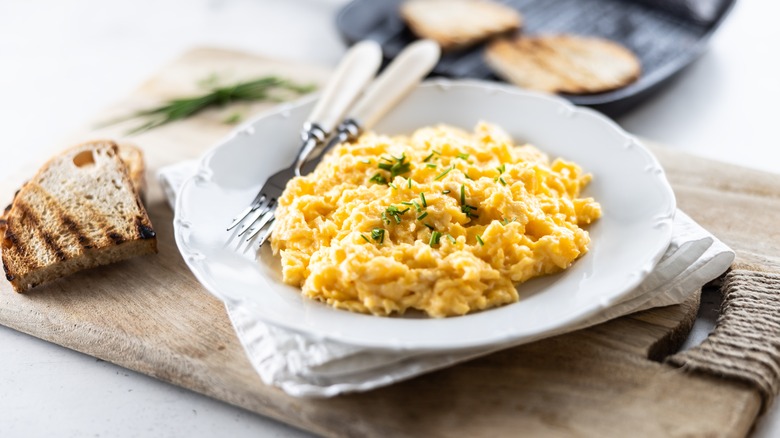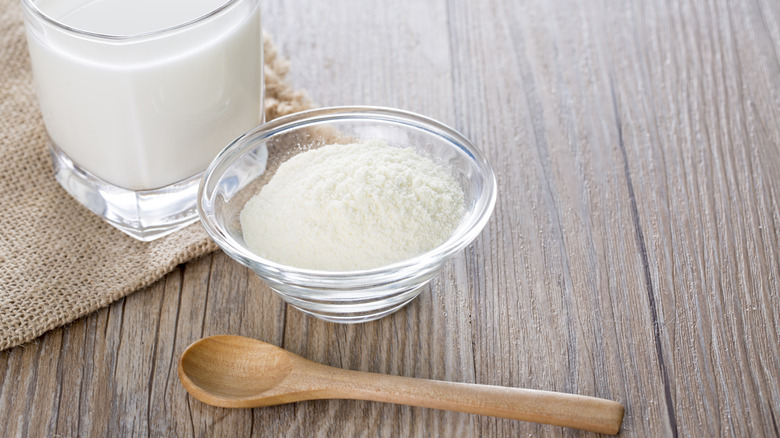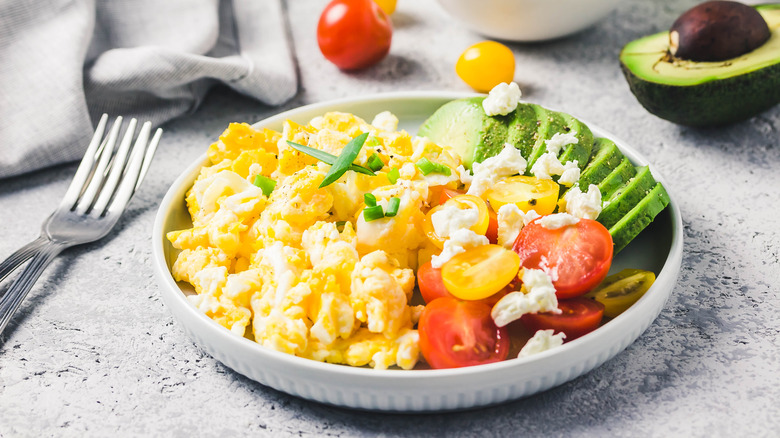Milk Powder Is A Slept-On Ingredient For Scrambled Eggs
Almost anyone with a culinary point of view has a strong opinion on the best way to scramble an egg. Among the many ingredients that celebrity chefs swear by for the fluffiest eggs, including mayonnaise, crème fraîche, soy sauce, potato starch, or even a little extra egg yolk, there's one in particular that might be flying under your radar, and that's milk powder.
While many cooks have adhered to the idea of adding a bit of milk to scrambled eggs, some professional food figures have a very adverse reaction to this practice. The objection is based on the notion that adding liquid milk to scrambled eggs thins out and dilutes the mixture, leading to a more bland flavor. A thinner mixture can lead to overcooking and subsequent dryness in your eggs. Adding milk can also give your scrambled eggs an unpleasant rubbery texture.
By using milk powder, however, you can bring the best parts of milk — the proteins, fats, and other nutrients — to your scramble without the unnecessary and troublesome extra liquid. The result is fluffy scrambled eggs with added layers of flavor and complexity, and none of the dry or rubbery qualities.
What is milk powder and why it works
Milk powder may sound like something from an astronaut's suitcase of rations, but it's actually a very useful ingredient right here on Earth. The ingredient is more or less exactly what it sounds like: the result of dehydrating milk (this can range from skim to whole milk, as well as milk alternatives).
When milk powder is toasted on its own, or cooked into a dish, it brings a nutty character, as well as that dairy creaminess (without the troublesome liquid of regular milk). Flavor-wise, it is more neutral than crème fraîche. Although milk powder may seem like a surprising element to add to your scrambled eggs, the science to explain this tip makes total sense. Milk powder is a sworn-by ingredient by professional chefs, and is often employed in baking to bring depth and intensity to everything from cookies to brownies, cakes, and breads without the trouble of extra liquid. It's especially handy when making ice cream, to increase the amount of milk fat without adding liquid. Perhaps unsurprisingly, it makes for a fantastic coffee creamer, and also has an extremely generous shelf life in comparison to standard milk, lasting anywhere from 18 months to 25 years.
More egg-cellent tips for your scramble
To try incorporating this ingredient, crack eggs into a bowl and add salt, pepper, or any other seasonings you enjoy in your scramble. Before you beat your eggs, instead of dosing the mix with a splash of milk, add a teaspoon of dehydrated milk powder. For a soft scramble, it's critical to have a little patience, cook over low heat, and continuously stir the eggs around the buttered or oiled pan, as the delicate nature of eggs can cause them to dry out quickly.
If your aim is to elevate your scrambling system, you can experiment with some other tips and hacks, too. For example, try adding a pinch of cream of tartar to your mix to help your finished product maintain structural integrity — in layman's terms, fluffiness — long after you've removed them from heat. For flavor, sweeten up your eggs with a drizzle of honey or maple syrup. Alternately, stick to savory flavors with an egg and cheese scramble, using cheddar or chèvre, or even bring an Italian flair by adding some parmesan. You can find more inspiration from the many ways scrambled eggs are enjoyed around the world, and experiment with everything from Spam to bitter melon. Whether you choose to try new flavors or keep it classic, with milk powder in your cooking arsenal, your scrambled eggs will be hard to beat.


